The What, When and Why of Window Treatments
A lot of you asked about a post on window treatments. There are a ton of options for every home- but I’ll share a bit about our most used types and why we use them!
First of all, we try to convince all our clients to use custom made drapery for the most part. It’s an expensive proposition, but one that pays off in a big way as nothing makes a room look more polished and finished than custom tailored window treatments. We work with an amazing workroom we love and trust but you can find one in your area through sources like Angie’s List and by asking friends who have had their homes done.
DRAPES
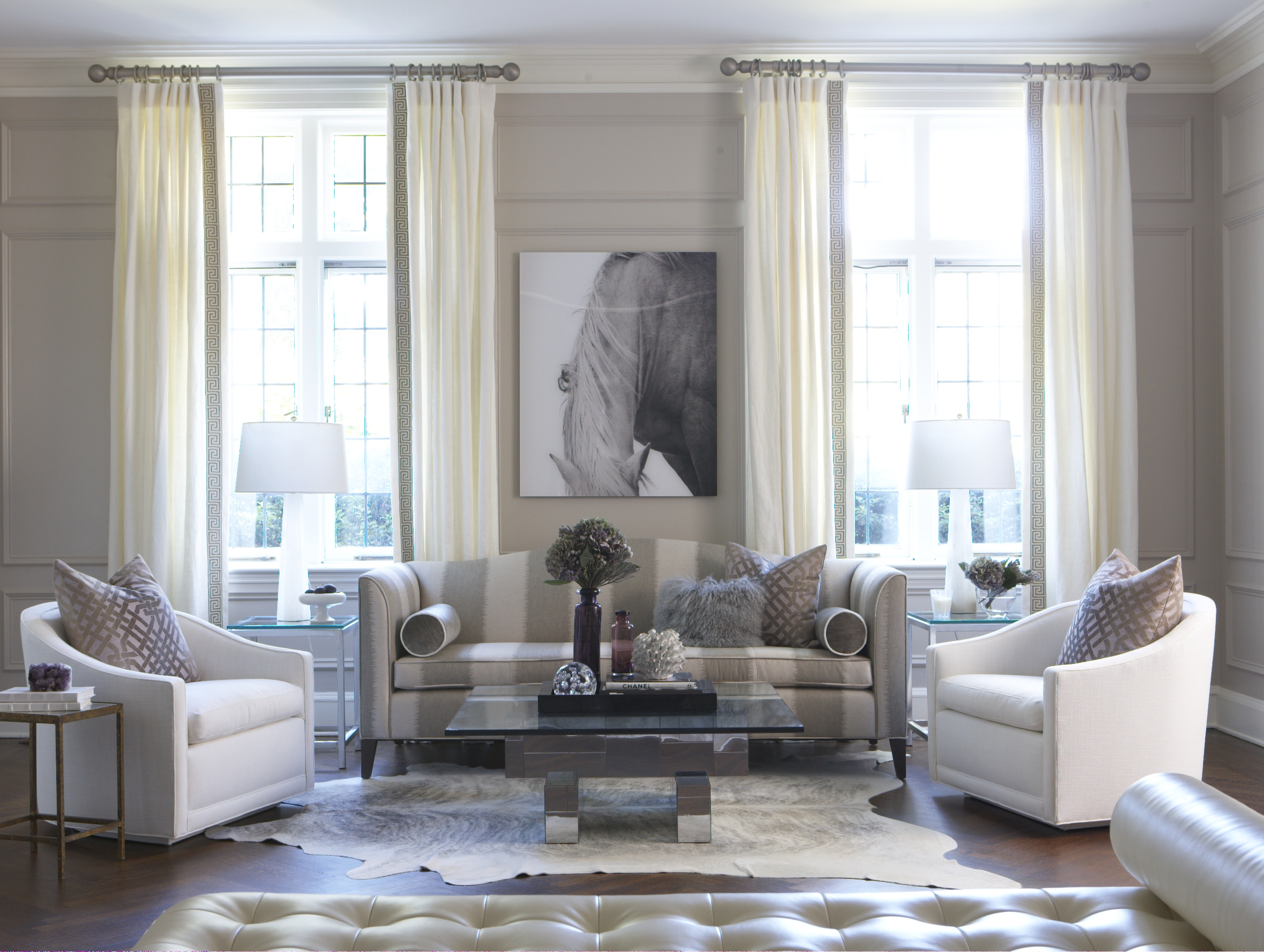
Dramatic but classic drapes with greek key trim- photo: Michael Partenio
Drapes add a nice amount of softness to a room and work wonderfully any space that has windows with no radiators underneath and space on the both sides of the trim for the hardware to properly extend and the drapes to fall mostly in front of the walls and trim and only a bit in front of the windows (to preserve the most sunlight coming into the room). On a simple single window about 42″ wide we extend the rods about 8″ or so past the window trim. And as a reminder, it looks best to install the rods close to the ceiling, about and inch or two below the crown moulding.
Custom rods are wonderful as they have no seams for extension and stay straight and strong and are available in a massive variety of materials. However, there are many sources for nice store bought hardware too- we use Restoration Hardware and West Elm a lot. Buy a size that needs the LEAST amount of extension- as rods bow at the seam when extended out far. So for example, on my windows that need a 55″ rod, I bought the ones that are 44″-108″ so that I don’t have to extend them too far out.
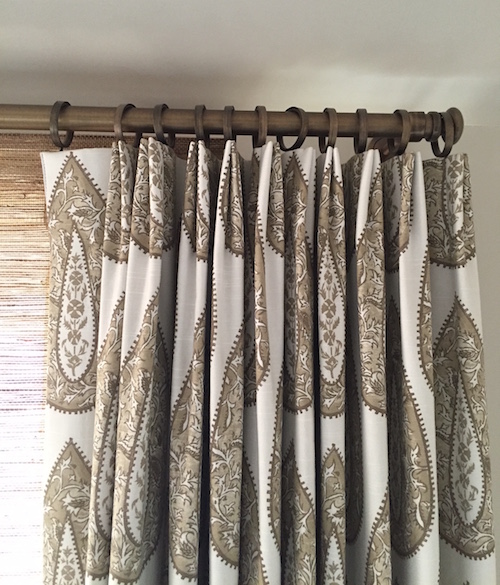
my favorite style of pleat
When having drapes made, I love a European or Parisian pleat- it’s a slightly more modern, clean pleat than the fussier ones that fan out at the top. We use these with rings and drapery hooks. Grommet topped panels are great for modern spaces and kids rooms (and are easy to buy from retail vendors). I avoid using rings with clips as they tend to look messy. Rod pocket drapes are a big NO NO, but back tab panels can look neat and tidy with no hardware needed beyond the rods.
In bedrooms we always line our drapes with blackout material. All draperies and window treatments should be lined or backed in white fabric so when looking at the windows from the outside of the house everything matches. We layer window treatments a lot- it looks so sumptuous and can be really functional. For example, in living rooms we love the look of woven wood roman shades paired with drapery panels. It provides a light filtering option for watching TV and night privacy without feeling blocked in by closed drapes.
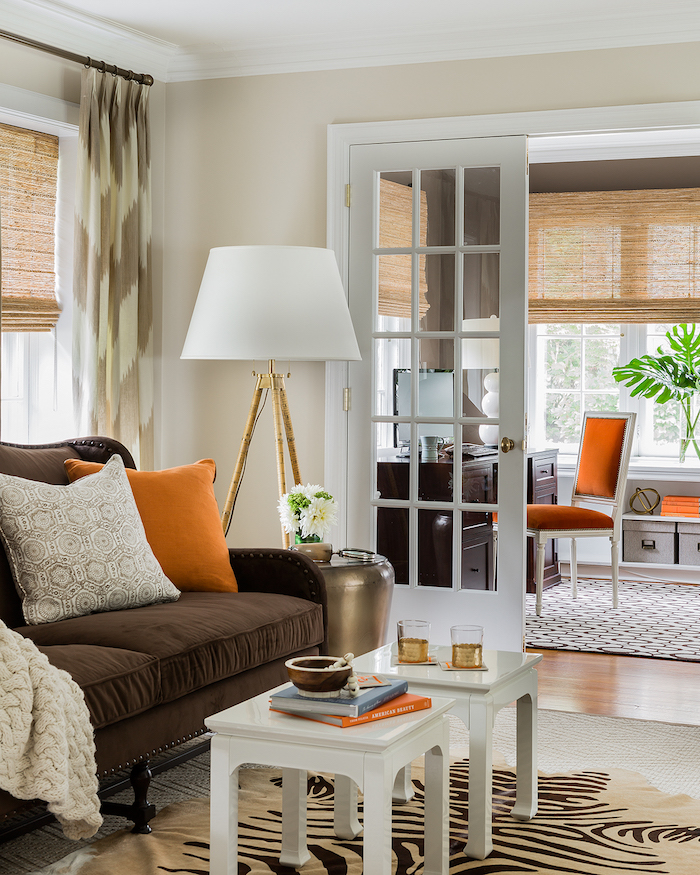
Layered drapes with woven woods and a separate room with woven woods alone- photo Michael J. Lee
Most of our panels end up being white linen with a nice decorative trim on the leads (the ends that meet when you close the drapes). As I said, custom drapes are expensive, but when done in a timeless classic color and style, can last a very long time and through several decor iterations. Greek key trim is a great choice because of its classic good looks and ability to look great in modern and traditional decor (try MJ Trim for a store bought source!) If using store bought drapes you can bring panels to a seamstress and ask them to sew on trim for semi-custom look. Patterned drapes give major drama and are the MOST fun to do- but be sure they are done in a pattern you will not tire of quickly. Check Etsy for makers of drapery panels in designer fabrics if you aren’t working with a designer!
ROMAN SHADES
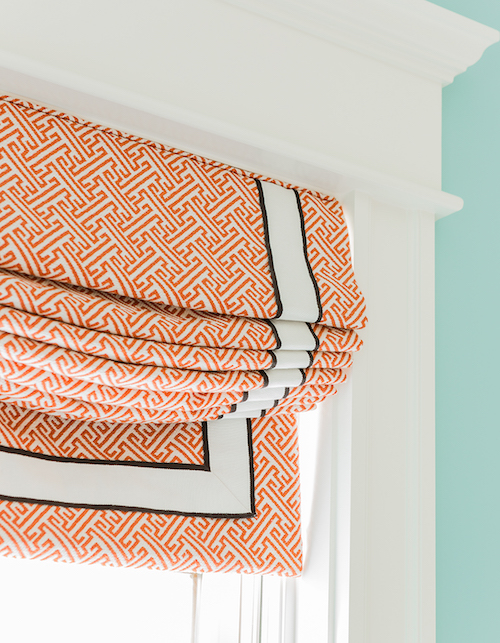
Detail of a fab inside mount roman shade we did for a little boy’s bedroom using two sizes and colors of grosgrain ribbon. Photo Michael J. Lee
The other most popular style we use in our work are fabric and woven wood roman shades. Fabric roman shades are great for spaces like kids rooms (nothing for little hands to grab), kitchens, bathrooms and any other windows where there are radiators below or adjacent walls too close for drapery hardware to be installed. There are so many versions of roman shades- we tend to use slightly relaxed styles the most as they look a bit more elegant. In more masculine and modern, clean spaces we use flat bottom. We either use cordless for safety or continuous loop chain for raising and lowering (string pulls are unsafe for children). I prefer to outside mount (mounted to the wall above and outside the window trim) roman shades if used alone as it lets way more light into the room when they are raised. The bottom of the shades should cover the top of the window trim and hang over the window only a few inches for maximum daylight. Inside mount (mounted inside the window frame as shown above) are great to use when layering under drapes or when window construction doesn’t allow for outside mounting.
For roman shades we like to also use whites and solids with either banding or trim on the edges or all three sides. It’s a fantastic way to add interest. Patterned romans are great too- especially in children’s rooms! And for bathrooms a nice patterned sheer is hard to beat, like this one in my bathroom in a favorite Martyn Lawrence Bullard fabric.

Shade in my master bath- sorry for the shit picture.
We use woven woods a lot in layering, as I said, but also alone for a simple, natural look that adds a nice dose of texture to a room. I like to outside mount these as well when used alone. There are so many places you can order these online- The Shade Store, Smith & Noble and Select Blinds being three good examples I’ve bought from. We always use the waterfall style of shade- I find the ones with valances at the top to be fussy looking. And a side note- if you layer woven woods with drapes and don’t need a blackout option- you can get away with doing stationary drapery panels which will cut down on your fabrics needs by a lot!
You absolutely can and should mix fabric roman shades and drapes in certain rooms that call for it- as I did in my master bedroom. I have a large roman shade in the window seat and drapes everywhere else- all in the same fabric to unify the look.
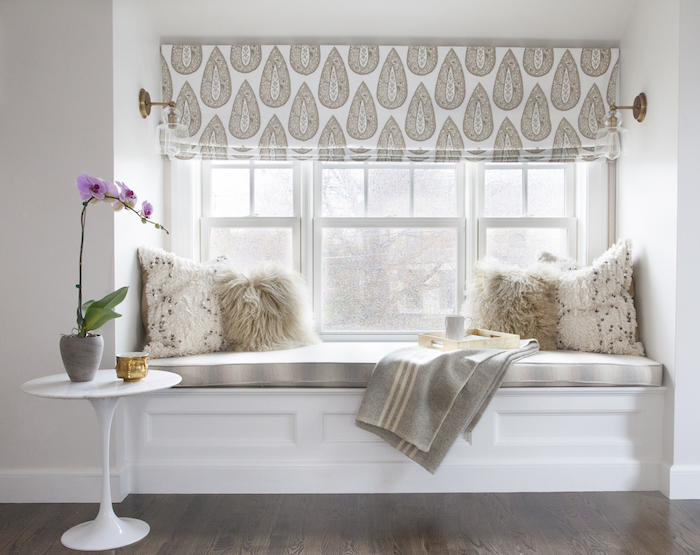
Large blackout roman shade in my master- photo Sarah Winchester
Valances
When a space calls for a treatment but not functionality, such as over a kitchen window, we love using faux roman valances. These look like roman shades but do not function and therefore use less fabric than a real roman shade that goes up and down. We also will use these kinds of valances to conceal windows that have roller shades in them. I mount these the same as I would a fabric roman shade- outside and up high falling just over the top of the window trim.
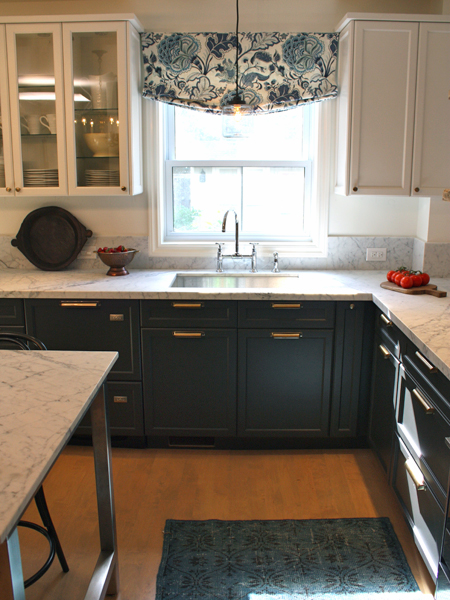
Any other specific questions?? I write more about window treatments in my book too!
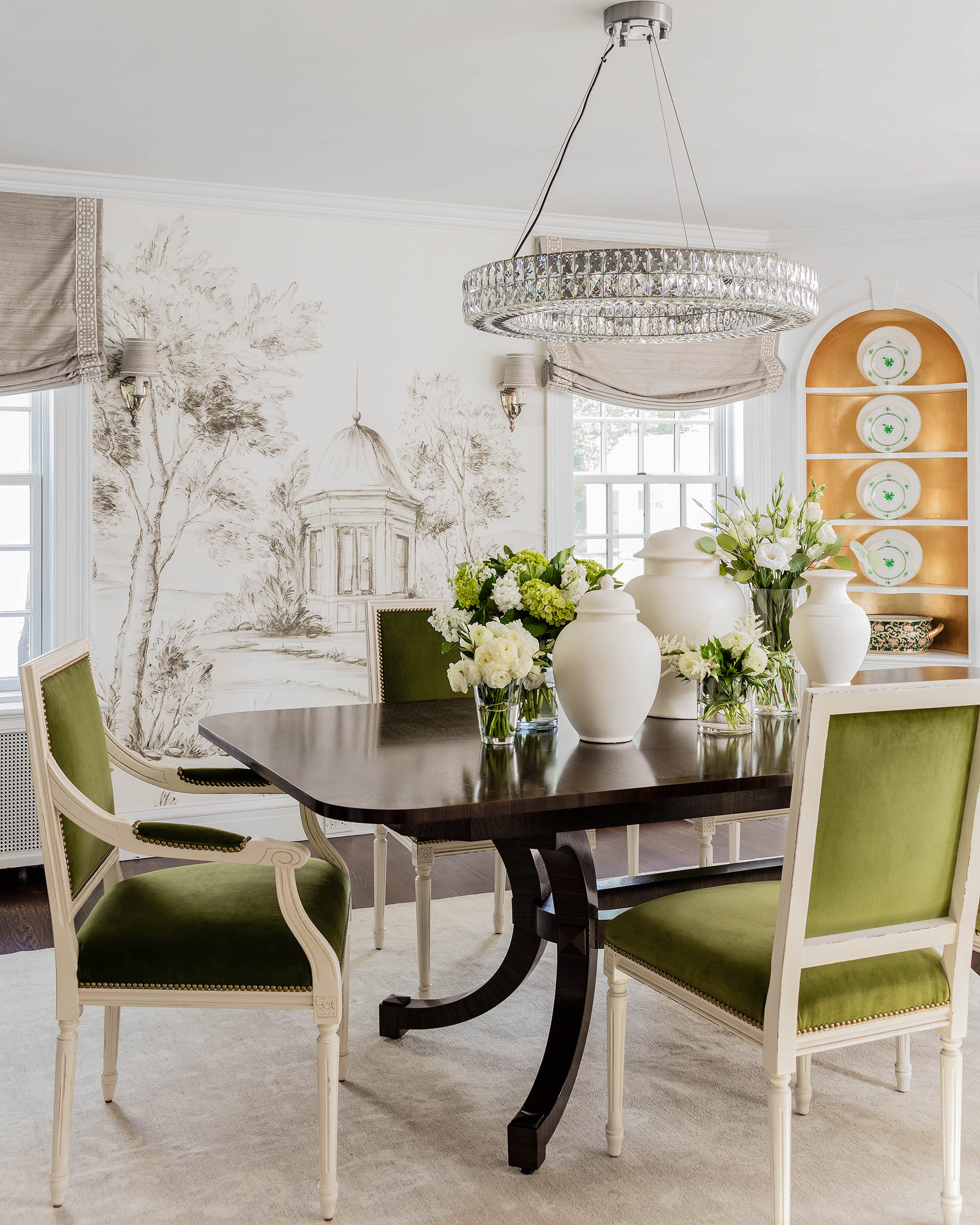

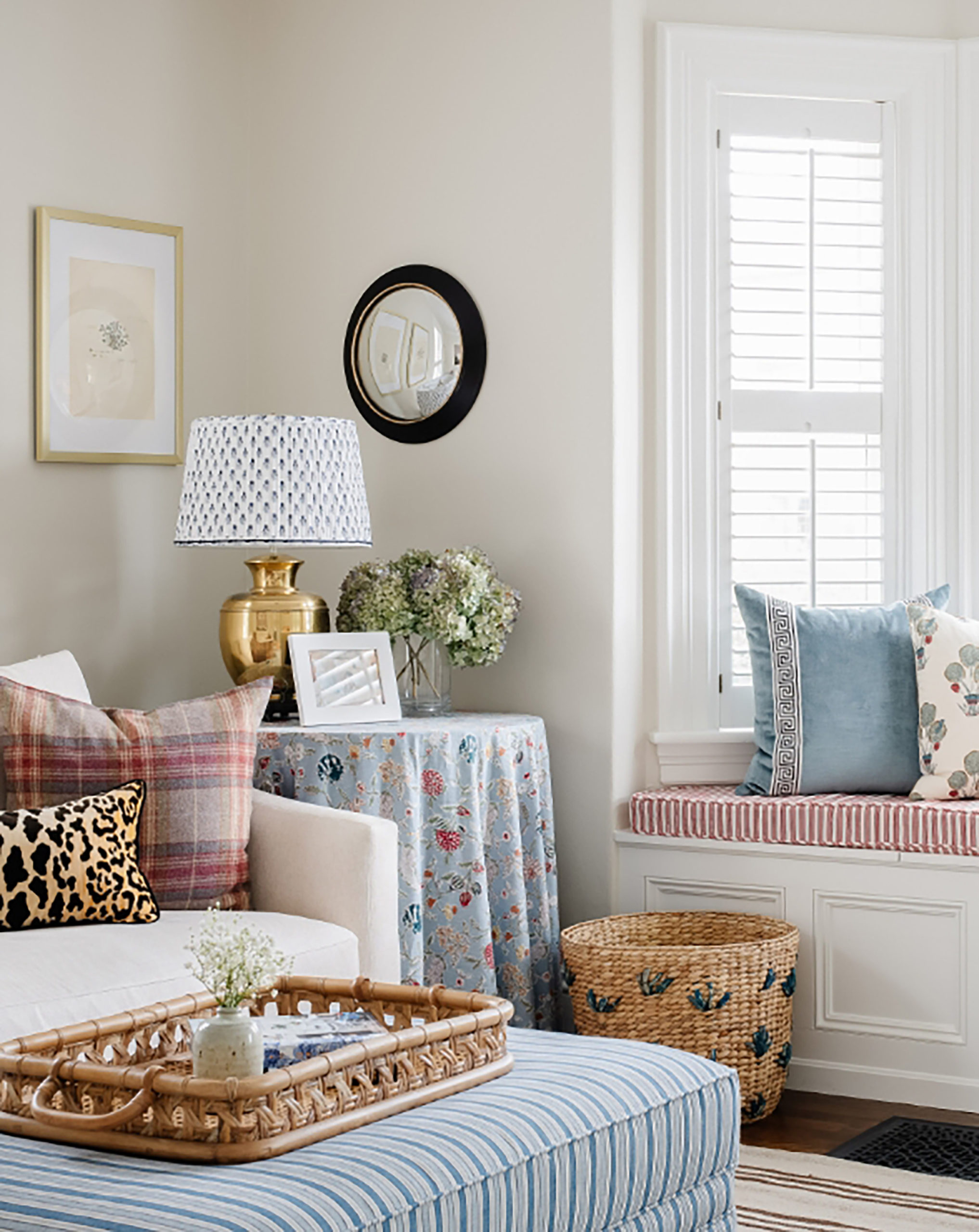



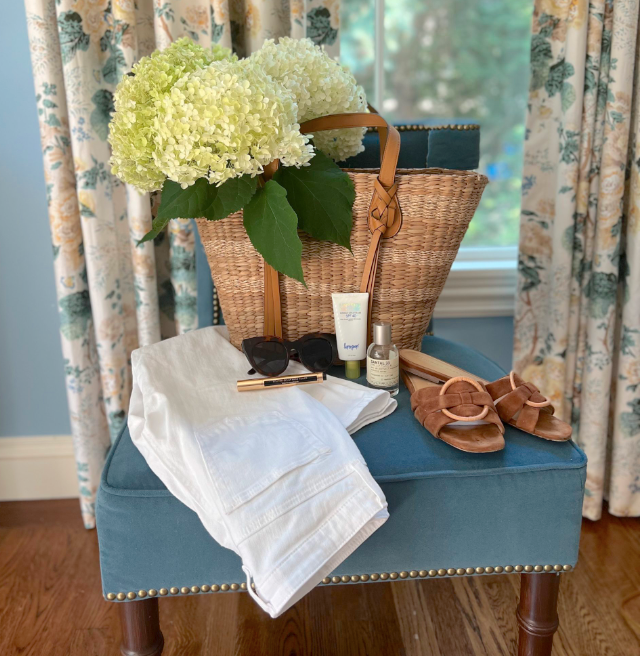
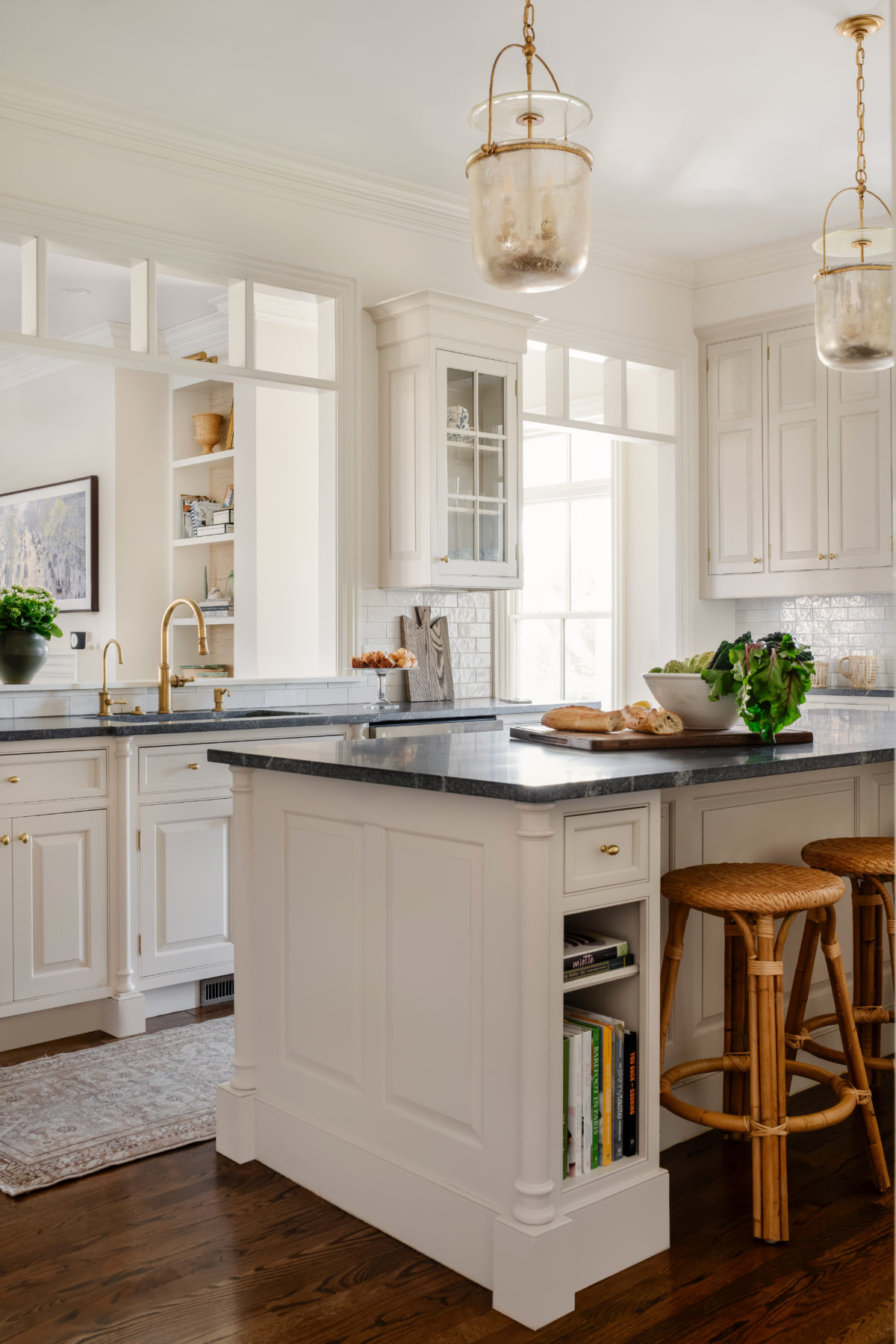
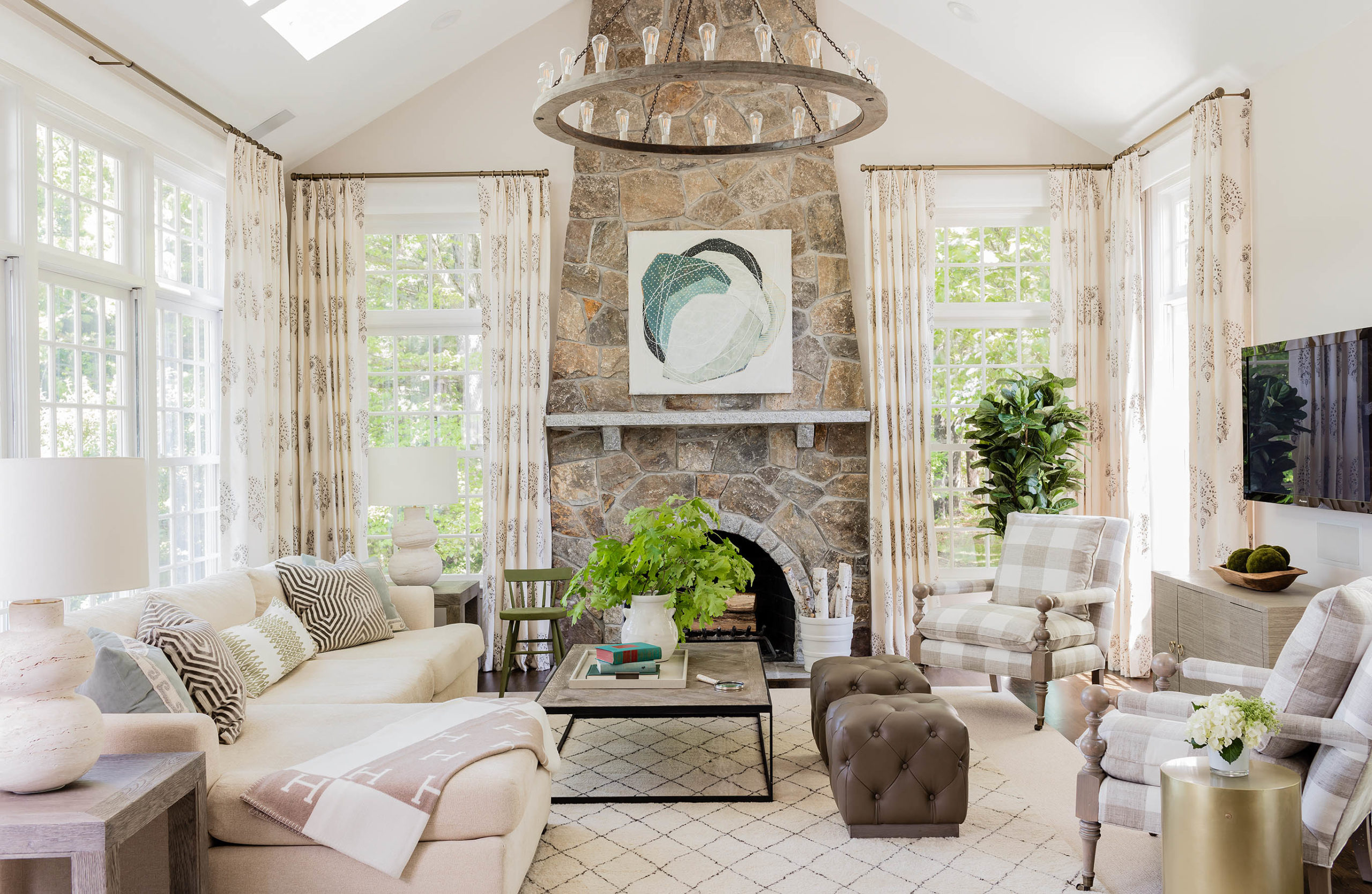
Always takes my breath away to see my home on your blog. Love, love love. xxx
I loved this post on drapes–it was so helpful as my husband and I are decorating our condo in Chicago. Would you also be able to do a similar post on Area Rugs? Recommended sizes for bedrooms / dining areas? Would love your insight! We went to Potterybarn and they recommended a 5×8 under a 72in long table. I love PB and typically find them helpful, however, I don’t think the 5×8 makes sense as the chairs would be half on and half off. The only other size option is an 8×10 and that almost seems too big for a condo. Are rugs absolutely necessary in a dining room? Any insight would be great! :)
Right now I’m trying to sort out what type of shades for each room although mostly all have bamboo with white linen curtains (except the living room has white wood blinds but we’re replacing very soon). anyway, my question is what about having one room with bamboo shades and one with fabric such as the bathroom or office? should all the windows have matching shades ? or just the ones facing the street? thanks!
Your master bath picture is indeed little bit blurry, but the shade pattern is clearly visible and GORGEOUS. :)
Lovely. Great article and explanation.
“Layered drapes with woven woods and a separate room with woven woods alone- photo Michael J. Lee” these does look astonishing.
Regards,
Abby
[…] 4. A super helpful post on window treatments. […]
[…] Window treatment basics from Elements of […]
Great post! Would you ever put roman blinds behind full length curtains? I am thinking about doing this on the windows (one a single window, one a double window) because the bed is up against the single window. It is too hard for people to be pulling the curtains closed when they want darkness…I thought dropping a roman blind would be easier. Do you think that would look ok?
Thank you! Would you do a similar post about the basics of lighting? I’m moving into a house that needs a lot of lighting help, and I’ve realized I have no idea where to begin.
Thank you so much for this. I am working on a renovation of two 17th century apartments in the south of France and have many 14-foot windows to treat. This offers so much guidance!
Thank you for this post! It is incredibly helpful as I contemplate the window treatments for our master bedroom. I also love the two layered rugs in the third photo — do you know where they are from? Thanks!
I have two large kitchen Windows, the fabric I like is 54 in wide but the windows at their narrowest trim on the inside mount are 56. Is there anything I can do to increase the diameter of the fabric I.e trim. I will probably end up doing a solar shade underneath bc the room is west facing and gets intense sun but even with a foe Roman shade I ru n into the same problem. I know I should pick a new fabric but I can’t. ?
or do a coordinating fabric border around the edges…as long as the seam is perfectly straight!
What type of window treatment do you recommend for a sliding door (with windows) to the backyard? I really hate the long, rotating strips that can be moved out of the way for using the door (not sure what they are called).
Great question!
Wonderful post Erin! When you say that you extend the rods about 8″ past the window trim of a 42″ window, do you mean 8″ on each side or 4″ on each side? I’ll be coming back to this post many times for guidance.
Great blog and beautiful photos! I love the Euro pleat style and am wondering if the workroom uses buckram in the header. They look so soft!
HI Erin, Great post. Im about to spec the Irwin Tripod standing floor lamp for a client. The tear sheet I have doesn’t do it justice and I was just wondering if the floor lamp in the third photo is the Irwin! I will show it to her if it is. A reply would be greatly appreciated! e
This is the definitely the most informative post you have done to date…thank you so much! So many questions about draperies. If they are done wrong, well, it’s just not good. Thanks again Erin for all the resources also.
Maryanne Sullivan
So helpful and timely, thank you!
I’m curious what linen or linen blend you feel makes the best drapes? Maybe slubby linen? It’s something I debate and feel like I haven’t found the perfect one yet that’s light/ airy, but doesn’t wrinkle super easily and look messy. Also, do you ever use a washable fabric for drapery panels in high traffic areas?
I love your blog- read it every day!
Monograms! Window treatments! You are knocking it out the park this week, Erin. Great and useful posts.
What about bay windows?
Thanks Erin. This is so helpful! What do you recommend for an arched window? It’s on the same wall as two rectangular windows. Thanks!
Love all your ideas about window treatments, but I love the pic of your wood flooring. We are currently replacing our entire home with wood floors…what brand/color are yours?
Hello Erin! Love, love the double-layer grosgrain ribbon trim. Um, just love grosgrain period. I wanted to trim a custom Roman shade with it once and was told not to use it as it tends to pucker when being sewn and won’t lie flat. What’s the secret? Is it truly ribbon or another flat trim??
The problem is that the fabric can stretch a bit when being sewn, but grosgrain does not. Wonder tape will help stabilize the ribbon/cloth layers to keep things in place, but not mess up your needle. Also, make sure that you are using a sharp needle and a walking foot probably wouldn’t hurt either.
Thank you, Jenna!
Thanks for the post! I am struggling with my study. I have two sets of french doors but they are only separated by about 36″ of wall space. My designer is recommending putting small rods on each side of the doors but that seems a little “model home” to me. I would like to put a long rod across the entire wall and just hang panels on each side of the doors but she disagrees because she thinks there will be too much fabric bunched in the middle. A valance is out because the doors open to the inside. Your advice would be much appreciated.
Just in case you do a part 2 on this subject…Could you share your feelings about upholstered cornice boards? Is there ever a situation when they can be appropriate? Or are they outdated?
I have one mounted above my foyer window with blinds underneath. Should I replace it with a Roman shade?
Thank you thank you!
My living room (soon to be moved to the bedroom) curtains have looked off to me and I couldn’t figure out why. Now I know it’s because I have rings and not hooks. I just ordered hooks and can’t wait to see how cleaner they look.
Vee
I am curious which cordless options you have had your workroom use for Romans? Roll ease? Or something else? I’m looking for a really great option for a client. GREAT post !!
Just bought a house today that has plantation shutters and no drapery whatsoever. Hubby and I like a modern look but those shutters are really pricey so we feel guilty thinking about taking them down (it’s not like you can sell custom plantation shutters on ebay…)
Would you add drapes to a window with plantation shutters or would that be too much? Honestly, I’ve never lived in a home with plantation shutters so I can’t picture it. Curious about your thoughts, thanks!
Erin- Was hoping you could tell us what hardware you used for your master? That tone has been very difficult to find and have been trying to source it for a long time! DYING to know!
How do you get total blackout for a window in a nursery? We’ve tried roman shades, but there is always the gap on the sides, which lets in two beams of light.
(Right now we have tinfoil covering the window panels — not the best look!)
Great post, TY!!!
Does your nice patterned bathroom sheer ( in the Martyn Lawrence Bullard fabric) provide real privacy? Or did you line it with something?
Thanks!
Excellent post and great information. I so agree that custom drapes make a room and are worth splurging on. They also last forever. Two questions- one about lining drapes- do you recommend interlining for custom drapes? If yes, does it depend on the material like silk vs. linen? And what length do you recommend for drapes?
This post is ????????? thank you SO much
Helpful post. What do you think about treatments for double glass sliding doors? We have some leading out to a patio. Feel like we’d like some privacy but nothing seems to look right.
What about working with a slider or french doors in a dining room? We have two large windows and a slider that we use a lot to get out to the back yard during the warmer months. Just curious on how you would add drapes (or not!) to them? Mind you we leave in the city and our neighbor just cut down our one tree so no more privacy/shade anymore…
Thank you!
Really helpful, thanks for sharing all the info! I really love your bedroom window seat, that roman shade is perfection
This is a great post. I have baseboard heaters that pretty much surround the perimeter of my house!! The faux roman shade for my kitchen would be perfect — I’ve just been searching for the right fabric. Thanks for all your ideas!
Window dressings are one thing I can NEVER figure out!
Alyssa
Feathers and Stripes
Great post! Can you comment about how much fabric to use on custom drapes? Do you do 1.5 or 2.5 full when doing drapes? Also, do you have a favorite resource for custom rods?
This is a great resource. Thank you. I would love to request a post on rugs! How do we know how large they should be? Do they all need to be the same type-all natural area, or can you mix and match. This is such an expensive item to “mess up!” Thank you! Love your blog and book!!
Great post…thanks for the vendor info and the guidance on going custom. Just hung drapes in our master after not having any up for a long while. Amazing how different the space feels. Taking note from previous posts on the subject and your book, we went to the top of the ceiling. The entire room feels bigger and our-already fairly high ceilings (about 10 ft-ish) feel even taller. My husband and dad commented on it and neither are known for noticing such details. Thanks for the tips!
Just curious–why don’t you like rod pockets? I was thinking about them on really fat poles for more casual areas…
They look very dated and fussy- clean pleats or a back tab option would look more current.
This is great info.! FWIW, I just ordered two 100% linen Suzanne Kasler lined drapery panels from Ballard Designs for my tween’s bedroom redo for a very reasonable price and am getting a local workshop to apply Greek key trim to the inside panel edges for a very reasonable $60. RH does have good window hardware — just ordered antique brass finish rods from them today. RH Baby & Child and RH Teen are two other good sources for drapery panels and hardware, I have discovered.
I have a patterned Roman shade above my kitchen window, similar to the one pictured, which thankfully is a fully functional Roman shade as my neighbor just cut down a tree that provided privacy between our homes, and now I really do need to lower that shade at night. Just a thought if privacy (or not wanting to look at the side of a dirty red brick triplex while doing dishes) is an issue in your kitchen.
I second the RH hardware. It is fantastically solid and easy to install.
This was SO helpful Erin! Have you ever noticed when browsing Pinterest that like 75% of home photos don’t feature window treatments? They are just not in the picture or completely removed/not installed. It’s so frustrating because window treatments are necessary for many of us but can really destroy the look of a room if done wrong.
I have a little riddle for you. I just posted my living room renovation today and the last thing I am really struggling with are the drapes, because I have an ENTIRE wall of windows. I know they are too long and I need to hem, but how do I make them not look so messy all the time?
see here:
https://thestylesafari.com/?p=8619
Thanks!
-Stefanie
This is SO helpful! Unfortunately I live in a 1930s row house so not only do we not have many windows (9 in the whole house) but they all have a radiator in front of them. I tried doing drapes in our living room and having them hang to the sides of the radiators but it just looked silly. We replaced them with plantation shutters which are a nice option and super popular down here in the South. We also have gotten fabric cordless roman blinds from JCPenney of all places. A really good option if you cant afford custom right now or are a renter etc.
Hi Erin: I’ve always struggled wth these drapery questions….In my dining room I have windows on two walls, no drapes currently. I want to get drapery but do not expect to ever close them, they would be more to just finish the room. One window spans almost 9 feet – since the drapes would be left open would it be weird to buy shorter width drapes (hence cheaper) that actually won’t cover the entire window? Also, I have french doors on a third wall, do I put drapes there as well? HHHEEEELLLLPPPP!!!!
Nope, this is a case in which I would do stationary panels (i.e. not able to close, just for show)- the only thing that stinks is you will need a custom rod most likely to fit…
Hi Erin, what are your thoughts on large 2 story great room windows . We have 3 seperate windows in a row with about 6″ in between each window. Then 3 large. “Viewing” windows stacked on top of the lower 3. Leaving them as is looks to bare but we don’t want to go over the top either. Help! ?
Loved this post! Such helpful information.
This is REALLY helpful! Thanks!!
Great post! I love drapes but our new home has a large radiator directly under the only window in the formal dining room. The space screams drapes, but with the radiator there, I can’t have the drapes to the floor look I am going for. I would fear that a Roman shade or valance will not have enough oomph. Any suggestions?
Such an informative post! I know this is one I will be referring to again and again. I have a question, though. I know you indicated drapes should not be used if you have radiators. Does that apply to baseboard heating as well? I recently gave our master bedroom a makeover and did not have our drapes hung because my husband said it blocks the heat. Debating if I should now consider roman shades.
This post is AMAZING! Thank you!
Thank you, Erin! Great post and perfect timing! I am struggling with our “modern” window in our sitting room. It is large (55″ wide x 78″ long), comes down to within 3 feet of the floor, and has NO casing or trim around the window opening, just a marble slab at the bottom. I love roman shades but am afraid it will look unfinished without the window trim and like a big sheet when fully drawn. Thinking I should stick with drapes, but would love to hear if you have dealt with this before. Thank you!
Loved this post…thank you! I’m in the process of setting up an office/guest room in a tiny room. The window is off center on a 100″ wide wall. There are 40″ of wall to the left of the window and 20″ to the right. I’m going to place a twin bed in front of the window (day bed style). Wondering what treatment to use on the window since long drapes would get squished. I’m leaning toward an outside mount roman shade but I’m having trouble visualizing it and I’m concerned it would look too austere and might draw more attention to the off centered window. Any direction you could give would be great.
You did say specific questions right? lol.
I had a similar problem in my old house. You could do a layered treatment with a roman shade and stationary drapes on the sides. Extend the drapes farther to one side than necessary to give the appearance that the window is centered. Since the drapes are only there for appearance, you don’t have to worry about them being fully functional and getting squished behind the bed. I hope that makes sense – I feel your pain with asymmetrical rooms!
Thank you Lauren! Unfortunately, in order to make room for a desk, the bed has to be tight against the wall. Also, I’ll have pillows arranged along the back so it can be used as a sort of day bed/lounge when not in use as a guest bed.
Hi Erin,
Love your blog it’s my go to for advice! What treatment would you use for a bay window in a dining room? totally lost!
Same question from me! I live in a typical New England apartment, and we have bay windows in the living room and dining room.
My gosh, what a fabulous and timely post! I tend to make my own treatments or use semi-custom window treatments because I’m handy and enjoy the process. Aside from my new master bath windows needing treatments (roman shades, haven’t decided on the design or how to mount them), I currently have a single set of curtains hanging in my living room with the pins still in them because I have yet to decide how they should be customized and/or if I should just layer in some roman shades. They have been there for less than 48 hours, but still…ugh.
Such great food for thought! Thanks!
What a great post! Thank you for the information! I do have a question……if someone were looking from the street at your home should the front windows all have the same style of window treatments? My mom says it looks better than to have different kinds. Also, what about shutters? Our new old home has all custom shutters. They are nice, but I prefer the look of drapes because of the natural light. I have thought about leaving the shutters in the eat-in kitchen area though. It’s a nice little nook that we will eventually add a banquette.
Hi Erin, Beautiful suggestions. I was just wondering what you meant by outside mount or inside mount. Not a professional here, but I love your blog for inspiration!
This is why you need an expert! Holy cow–thanks for the information, although incredibly overwhelming. This will be a post I re-read 100 times, to make sure I selecting the right look. thanks Erin!
As usual, your timing couldn’t have been more perfect for this post. I had a client ask if we could do custom drapes in 3 rooms for less than $1,800. THANK YOU for saying they’re expensive! And yes, they are an investment! And they’re important and what make a room look custom and designer-y! Ugh. At least I have your beautiful eye candy to look at since all my sourcing just went out the window…
I should also note that I live in Kansas so $1000/window is likely a very conservative number. Fabricut? Sure. Scalamandre? Nope. Haha!
what would the variance be for a valance / roman shade?
Yes, I’d say a pair of custom drapes with trim will run clients about $1,500 per window with fabric, trim, labor and installation.
Agreed! I tend to tell clients to expect $1000/window (unless it’s small or huge). It’s frustrating because this seems to be one of the areas where clients have the most unrealistic budgets/expectations.
I feel like all that was missing from this post was “the more you know” rainbow at the end!! Amazing!! Thank you for breaking this down in such an approachable and no-nonsense sort of way. I also appreciate the notion that I can mix treatment styles while unifying the look by using the same pattern. Brilliant! Thank you!
The kitchen valance makes total sense to me for small windows (exactly as you have pictured, over a sink), but what do you suggest for larger kitchen windows? Is a valance too much? Drapery seems unnecessary. But having nothing seems too bare. We have a valance over the sink window, but three large windows have nothing but blinds, because I can’t figure out what to do with them. WWEGD??
I left three large windows above our kitchen banquette bare for years until the glare at certain times of the morning got to me, and I ordered white matchstick-type blinds, which are mainly raised but look awesome lowered as well. I was inspired by the windows in Furlow Gatgewood’s home profiled in Julia Reed’s “One Man’s Folly,” which are very casual natural matchstick blinds throughout and look fabulous!
On very large window I would leave bare if no treatment is necessary for glare/ light diffusion!
Thank you!